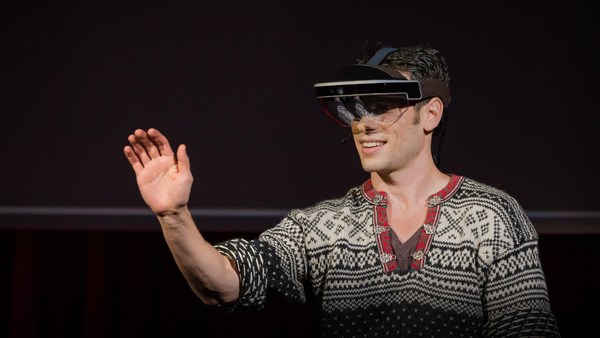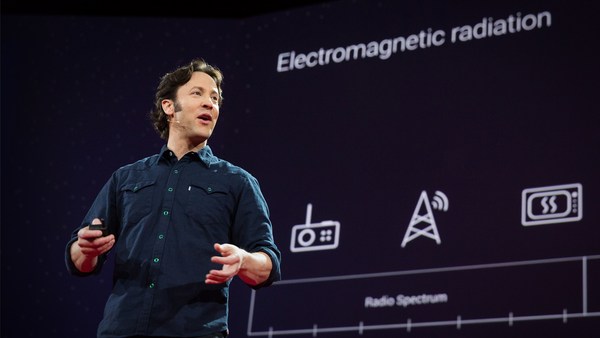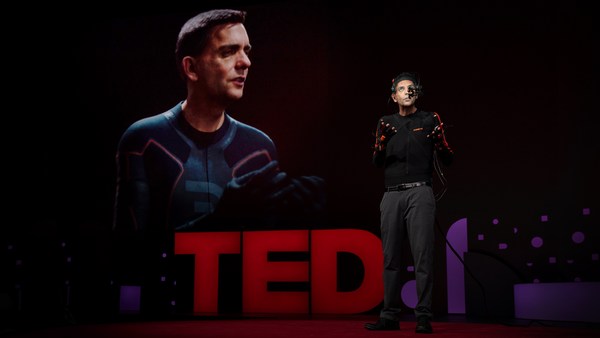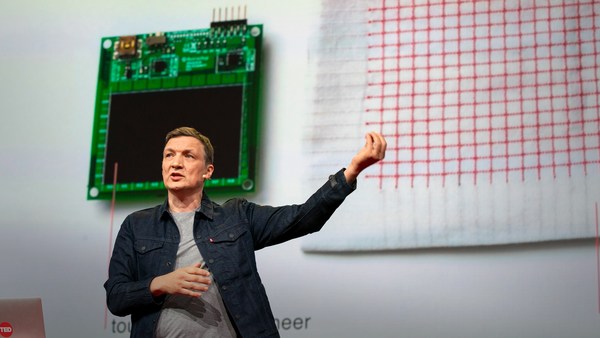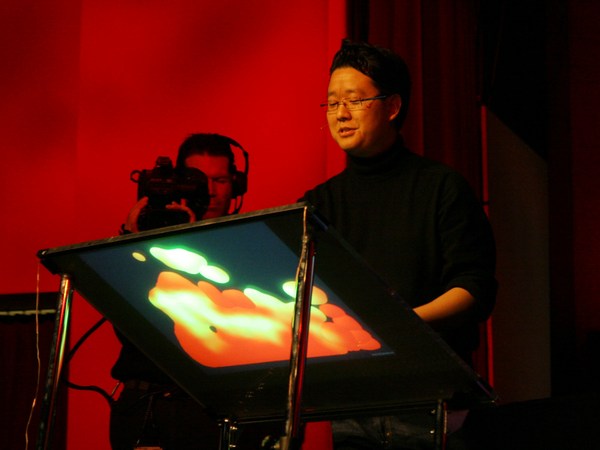Thousands of years from now, we'll look back at the first century of computing as a fascinating but very peculiar time -- the only time in history where humans were reduced to live in 2D space, interacting with technology as if we were machines; a singular, 100-year period in the vastness of time where humans communicated, were entertained and managed their lives from behind a screen.
Today, we spend most of our time tapping and looking at screens. What happened to interacting with each other? I don't know about you, but I feel limited inside this 2D world of monitors and pixels. And it is this very limitation and my desire to connect with people that inspires me as a creator. Put simply: I want to create a new reality, a reality where technology brings us infinitely closer to each other, a reality where people, not devices, are the center of everything.
I dream of a reality where technology senses what we see, touch and feel; a reality where technology no longer gets in our way, but instead embraces who we are. I dream of technology on a human path. We have all experienced technology that enables people to act more like people, products that enable natural interactions, voice controls or biometrics.
This is the next step in the evolution. This is Microsoft HoloLens, the first fully untethered holographic computer. Devices like this will bring 3D holographic content right into our world, enhancing the way we experience life beyond our ordinary range of perceptions. Now, I'm not thinking about a distant future. I'm talking about today. We are already seeing car companies like Volvo designing cars differently with HoloLens; universities like Case Western redefining the way medical students learn; and my personal favorite, NASA is using HoloLens to let scientists explore planets holographically.
Now, this is important. By bringing holograms into our world, I'm not just talking about a new device or a better computer. I'm talking about freeing ourselves from the 2D confines of traditional computing.
Put it this way: temporally adjusted, we're like cave people in computer terms. We've barely discovered charcoal and started drawing the first stick figures in our cave. Now, this is the perspective I apply to my work every single day. And now for the next few minutes, I invite all of you to apply the same perspective to the journey ahead of us.
Now, as I put this HoloLens on, let me explain the setup a little bit. It's probably the most risky demo we have ever done on any stage with HoloLens, and I can't think of a better place to do it than here at TED. Momentarily, I am going to be seeing holograms right on this stage, just as clearly as I can see all of you. Now at the same time, we have also this special camera that just walked in onstage so that all of you can share in this experience with me up on all the monitors.
So let's start our journey. And what better place to begin our journey, than in the computer cave of 2D. Let's explore the world all around us with this new lens, and understand the computer world from a brand new perspective.
The computer universe is both marvelous and primitive. It's a universe based on causality. As developers, we dream the different causes and then we program the different effects. Double click on an icon, that's a cause. Open an application, that's an effect. Now when we compare this to our physical universe, it is overly constraining, because our universe is not digital. Our universe is analog. Our universe doesn't think in terms of zero or one, true or false, or black or white. We exist in a world governed by quantum physics, a universe of zero and one both at the same time, a reality based on infinite probabilities and shades of gray. You can see how these two worlds collide.
So why are screens so pervasive in our analog life? We see screens from the moment we wake up, to the moment we fall asleep. Why?
I think it's because computers give us superpowers. Within the digital universe, we have the power to displace space and the power to displace time. It doesn't matter if you're using technology for entertainment, productivity or communication. Think of it this way: let's all go home tonight and watch our favorite show on television. This is theater -- time and space displaced. As soon as I'm done with this TED Talk, I'm going to immediately call my lovely family in Seattle. That's displacement of space. Now, these are such great superpowers that we put up with the two-dimensional limitations of our current digital world. But what if we didn't have to? What if we could have these same digital powers in our world? You can already see glimmers of this, but I believe our children's children will grow up in a world devoid of 2D technology. It's remarkable to dream of this world, a world where technology truly understands us -- where we live, work and communicate -- with tools that enhance the human experience, not machines that limit our humanity.
So how do we get there? For me, the answer required looking at the problem from a different perspective. It required sensing the world from the perspective of a machine. If you're a machine trying to sense our world, how would you actually break the problem down? You'd probably try to classify things as a human, an environment or an object. But how would that machine then interact with reality? And I can think of three ways.
First, as a machine, I would observe or I would input reality. Speech recognition and biometric authentication are great examples of a machine interacting with humans from an input perspective. Secondly, as a machine, I could place digital information, or output information, into reality. Holograms are examples of a machine interacting with an environment from an output perspective. Finally, as a machine, I could exchange energy with the world via haptics. Now, imagine being able to feel the temperature of a virtual object, or better yet, imagine pushing a hologram and having it push you back with equal force.
With this perspective, we are able to collapse reality into a simple matrix. Now here's a secret: as an engineer, I get really excited anytime I can reduce something to the matrix. From self-driving cars to smartphones to this holographic computer on my head, machines are becoming capable of understanding our world. And they are starting to interact with us in significantly more personal ways.
Now, imagine having granular control over everything in the world. Move the dial one way, and you get reality. Move the dial the other way, and you get virtual reality. Now, imagine dialing your entire environment between virtual and real worlds. I love it down here. Now, imagine if I could look at all of you and dial from real humans into elves. When technology truly understands our world, it will again transform the ways we interact, the ways we work and the ways we play.
Less than half a century ago, two courageous men landed on the moon, using computers that were less powerful than the phones in your pockets. Six hundred million humans watched them on grainy, black-and-white televisions. And the world? The world was mesmerized.
Now imagine how our children and their children will experience the continued exploration of space with technology that understands this world. We already live in a world where real-time universal translators exist. And I can squint, and I can already see holographic telepresence in our near future. In fact, since we've been lucky with our demo so far, let's try doing something else even more crazy. I invite you to experience, for the first time anywhere in the world, here on the TED stage, a real-life holographic teleportation, between me and my friend, Dr. Jeffrey Norris, from NASA's Jet Propulsion Laboratory.
Finger crossed. Hi, Jeff.
Jeff Norris: Hey, Alex.
Alex Kipman: Phew! That worked. How are you doing today, Jeff?
(Applause)
JN: Doing great. I had an awesome week.
AK: So, can you tell us a little bit, Jeff, about where you are?
JN: Well, I'm actually in three places. I'm standing in a room across the street, while I'm standing on this stage with you, while I'm standing on Mars, a hundred million miles away.
AK: Wow, a hundred million miles away. This is crazy! Can you tell us a little bit more about where all this data from Mars is coming from?
JN: Absolutely. This is a precise holographic replica of Mars, built from data captured by the Curiosity Mars Rover, that I can explore as easily as a place on Earth. Humans are natural explorers. We can instantly understand an environment, just by being present in it. We've built tools like our Mars Rover to extend our vision and lengthen our reach. But for decades, we've explored from a seat behind screens and keyboards. Now, we're leaping over all of that, over the giant antennas and the relay satellites and the vastness between worlds to take our first steps on this landscape as if we were truly there. Today, a group of scientists on our mission are seeing Mars as never before -- an alien world made a little more familiar, because they're finally exploring it as humans should.
But our dreams don't have to end with making it just like being there. When we dial this real world to the virtual, we can do magical things. We can see in invisible wavelengths or teleport to the top of a mountain. Perhaps someday, we'll feel the minerals in a rock just by touching it. We're taking the first steps. But we want the whole world to join us in taking the next, because this is not a journey for a few, but for all of us.
AK: Thank you Jeff, this was amazing. Thank you so much for joining us on the TED stage today.
(Applause)
JN: Thank you Alex, bye bye.
AK: Bye, Jeff.
(Applause)
I dream about this future every single day. I take inspiration from our ancestors. We used to live in tribes where we interacted, communicated and worked together. We are all beginning to build technology that will enable us to return to the humanity that brought us where we are today -- technology that will let us stop living inside this 2D world of monitors and pixels, and let us start remembering what it feels like to live in our 3D world. It's a phenomenal time to be human.
Thank you.
(Applause)
Helen Walters: Thanks so much. I have some questions.
AK: OK.
HW: So there's been some talk in the press. And I'll just ask you straight, then we have a straight answer. There's been talk about the difference between the demos and the reality of the commercial product. Talk about this field of view issue. Is this type of experience what someone who buys the product will get?
AK: It's a great question, Or, said better, this is a question we've been receiving in the media for possibly the last year. If you do your research, I haven't answered that question. I've purposely ignored it, because ultimately, it's the wrong question to ask. That's the equivalent of me showing holograms to someone for the first time, and you then saying, "What's the size of your television?" The field of view for the product is almost irrelevant. What we should be talking about is the density of lights, or radiance, that shows up. Better said, what the angular resolution is of the things that you see. So from that perspective, what you saw -- you know, the camera is wearing a HoloLens. So even if I wanted to cheat, I can't.
HW: But the camera has a different lens on it than our eye. Right?
AK: The camera has a fish-eye lens on it. It's seeing a much wider view than the human eye is. So if you think about the points of light that show up radially from the vision of the camera, which is the thing that matters: how many points of light can I get in a given volume? That's the same as I get on this HoloLens as I will on that one. Now, this camera sees a much wider view of the world, right?
HW: Jesus Christ!
(Laughter)
AK: He did show up! I told you he'd show up. Come this way.
(Laughter)
HW: Oh, shit.
AK: And there's holographic Jeff Norris.
HW: I knew something was happening, but I really wasn't sure what.
AK: So in short: to be super crisp, the camera that you see on the screen has a wider field of view than the human eye. But the angular resolution of the holograms that you see, the points of light per unit of area, are actually the same.
HW: So you spent -- Jeff, I'll get to you in a minute -- so you spent a lot of time mapping the stage --
AK: That's right.
HW: So help me out here: if I buy a HoloLens and have it at home, I don't need to map my apartment, right?
AK: The HoloLens maps in real time at about five frames per second, with this technology that we call spatial mapping. So in your home, as soon as you put it on, holograms will start showing up, and you'll start placing them and they'll start learning your home. In a stage environment where we're trying to get something on my head to communicate with something over there with all of the wireless connectivity that usually brings all conferences down, we don't take the risk of trying to do this live. So what we do is pre-map the stage at five frames per second with the same spatial-mapping technology that you'll use with the product at home, and then we store it, so that when there's shenanigans of wireless in an environment like this, between the camera's HoloLens and the one on my head, we don't have things disappear. Because ultimately, the holograms are coming from this HoloLens, and that one is just viewing the HoloLens. So if I lose connectivity, you would stop seeing beautiful things on the screen.
HW: And it was beautiful. Um ... Jeff?
JN: Yes?
HW: Hi.
AK: I'll take a step back.
HW: So Jeff, you were on Mars, you were here, you were in a room across the street. Tell me more about the fact that, with holograms, you have sight but you don't have touch, you don't have smell. Is this scientifically useful now? That's my question for a hologram.
JN: Thanks for the question. Absolutely, I believe that these technologies are scientifically useful right now, and that's why we're using them in multiple parts of our work at NASA. So we're using it to improve the ways that we explore Mars. We're also using it for our astronauts on the space station. We're even using it now to design the next generation of our spacecraft.
HW: Amazing. OK, Jeff, please go away. Thank you very much.
(Laughter)
Alex, really, that was amazing. Thank you so much.
AK: Thank you.
HW: Thank you. Thank you.
(Applause)
